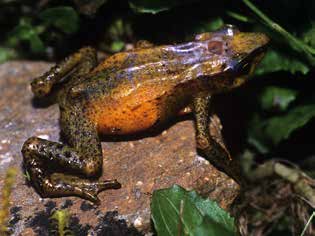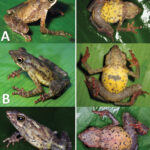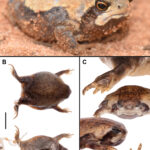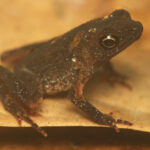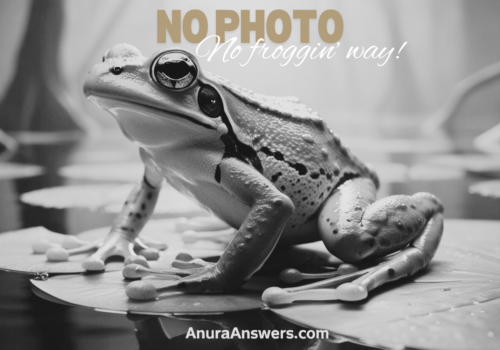- Atelopus mucubajiensis: The Enigmatic Harlequin Frog of the Venezuelan Andes
- Taxonomy and Classification
- Natural Habitat: Among the Cloud Forests and Páramos
- Physical Characteristics: Mastering the Art of Warning and Concealment
- Behavior and Life Cycle: Secrets of Survival Above the Clouds
- Ecological Role: Guardian of Environmental Health
- Threats and Conservation Status: An Amphibian on the Brink
- Cultural and Scientific Significance: More than Meets the Eye
- Conclusion: Ensuring a Future for Atelopus mucubajiensis
Atelopus mucubajiensis: The Enigmatic Harlequin Frog of the Venezuelan Andes#
Hidden amidst mist-kissed peaks and verdant montane forests, the small yet captivating Atelopus mucubajiensis, commonly known as the Mucubají Harlequin Frog, exists at the delicate intersection of beauty and vulnerability. This enigmatic amphibian, whose scientific name derives from its locality at Laguna Mucubají in the Venezuelan Andes, represents much more than a charismatic symbol of biodiversity. It serves as a vital indicator of ecological health in one of the world’s most biologically rich yet fragile mountain ecosystems. With a striking coloration that seems painted by an artist’s careful brush, it tells a story of evolutionary adaptation, ecological interdependence, and a sobering call for conservation action amidst rapidly changing environments.
Before we delve into the fascinating details of this frog’s intricate life, captivating behaviors, ecological significance, and its ongoing struggle for survival, consider this remarkable fact: despite their tiny size and seemingly delicate nature, many harlequin frogs—including Atelopus mucubajiensis—possess potent toxins, earning respect from potential predators and intrigue from researchers.
Taxonomy and Classification#
Atelopus mucubajiensis belongs to the Bufonidae family, familiarly known as the “true toads.” However, the vibrant colors and slender build of this frog contrast starkly with the typical image many associate with the word “toad.” Belonging to the genus Atelopus, this species is part of a charismatic group known as the “harlequin frogs,” named for their vibrant colors and distinct visual patterns that resemble the bold attire of traditional jesters or harlequins.
First described scientifically in 1974 by Venezuelan herpetologists La Marca and Reinthaler, this mesmerizing amphibian was identified at Laguna de Mucubají in Venezuela, lending to its name. Within its taxonomic family, Atelopus mucubajiensis shares close kinship with such remarkable species as Atelopus carbonerensis and Atelopus oxyrhynchus, among others, all recognized for similar bright coloration and specialized habitats.
Natural Habitat: Among the Cloud Forests and Páramos#
Cradled in the Andes Mountains of Venezuela, the Mucubají Harlequin Frog thrives in a unique blend of cloud forests and high-altitude grasslands known as páramos. These distinct ecosystems are characterized by their perpetually moist air, cool temperatures, and enchanting landscapes shrouded often in rolling fog. Specifically, Atelopus mucubajiensis can be found at elevations ranging from approximately 2,300 to 3,500 meters, areas where day and night temperatures fluctuate dramatically and atmospheric conditions increase the complexity of life.
These resilient amphibians tend to favor swift-running, clear mountain streams nestled within dense vegetation—habitats that offer both shelter and plentiful prey. The lush plant life and abundant moisture create a delicate microclimate that supports not only frogs, but a complex web of organisms, from insects and small invertebrates to various birds, mammals, and other amphibians. It’s within these intricate ecosystems that Atelopus mucubajiensis interacts continuously, playing its ecological role while depending profoundly upon habitat stability for its own survival.
Physical Characteristics: Mastering the Art of Warning and Concealment#
At a modest size rarely exceeding four centimeters from snout to vent, Atelopus mucubajiensis packs a visual punch disproportionate to its diminutive stature. It sports an arresting coloration palette that includes brilliant yellows, deep blacks, and vivid oranges, arranged in intricate, individualized patterns. This coloration is no mere show: it serves a dual evolutionary purpose. The striking, aposematic coloring wards off predators by signaling its toxicity, effectively communicating danger without the frog ever needing to defend itself physically. Meanwhile, against a backdrop of leafy shrubs and moss-covered rocks, these vibrant hues blend surprisingly well, offering effective camouflage among the dappled sunlight and shadows of their natural habitat.
Its skin is smooth, unlike the rough, textured skin most people associate with toads, and its limbs elongated, perfectly adapted for navigating rugged terrain and swift currents. Like many mountain-adapted amphibians, the tips of its toes are slightly rounded, aiding in gripping slippery rocks and vegetation in its streamside habitat.
Behavior and Life Cycle: Secrets of Survival Above the Clouds#
Feeding and Hunting Strategies#
Active mainly during the day, the Mucubají Harlequin Frog emerges from hiding places amidst moist foliage to hunt and feed. Its diet consists predominantly of ants, beetles, spiders, and small insects abundant in its montane habitat. Guided by keen eyesight and quick reflexes, it waits patiently and quietly before suddenly striking at prey with remarkable speed and accuracy.
Mating Rituals and Reproductive Strategies#
When the seasonal rain arrives, signaling ideal conditions for reproduction, male frogs begin their courtship performances—a chorus of calls that echo gently through the mountain valleys—seeking attentive females. This musical advertisement serves both to attract potential mates and to announce territories, reducing aggressive encounters among rivals.
Once paired, the female Atelopus mucubajiensis lays her eggs in shallow, slow-moving portions of mountain streams—clumps of tiny, gelatinous orbs laid gently upon submerged rocks or underwater vegetation. After fertilization, she leaves these eggs to the mercy—and protection—of crystal-clear waters. Noteworthy among amphibians, harlequin frog tadpoles possess specialized mouthparts enabling them to graze on algae growing across the submerged rocks, thriving until transformation occurs.
Indeed, successful metamorphosis is a precarious process reliant upon pristine water conditions and a delicate ecological balance, key factors that underscore the vulnerability of Atelopus mucubajiensis to disturbances in its environment.
Ecological Role: Guardian of Environmental Health#
Perhaps one of the greatest values of the Mucubají Harlequin Frog lies beyond its distinctive beauty and fascinating behavior—in its indispensable role as an indicator species. Amphibians, highly sensitive to changes in water quality, temperature, atmospheric conditions, and pathogens, often reflect swiftly and profoundly any ecological disturbance.
Because of this inherent sensitivity, the decline or thriving of Atelopus mucubajiensis is a direct gauge of environmental health in the Venezuelan Andes, alerting researchers and conservationists to subtle changes in ecosystems, sometimes before more resilient species experience any measurable distress.
Threats and Conservation Status: An Amphibian on the Brink#
Unfortunately, Atelopus mucubajiensis is listed as Critically Endangered on the International Union for Conservation of Nature (IUCN) Red List. Populations have declined dramatically, primarily from habitat destruction, pollution of waterways, climate change altering its delicate mountainous microhabitats, and, devastatingly, the global spread of the chytrid fungus (Batrachochytrium dendrobatidis).
This pathogenic fungus, responsible for devastating amphibian populations across the globe, has proven particularly deadly for harlequin frogs and poses a daunting conservation challenge. In response, biologists and local conservation groups have initiated vital habitat restoration projects and captive breeding programs aimed at bolstering wild populations. Nevertheless, continued efforts, combined with increased public awareness and governmental support, remain crucial to preserving this species for future generations.
Cultural and Scientific Significance: More than Meets the Eye#
Atelopus mucubajiensis resonates beyond science. Indigenous communities across the Andean region have long viewed frogs as spiritual symbols of life, renewal, fertility, and ecological balance, highlighting deep cultural connections and reverence for local ecosystems.
From a scientific perspective, research involving Atelopus encompasses studies on evolutionary biology, toxicology, climate adaptation, and disease biology. Each finding provides crucial insights for broader ecological and biological understanding, enriching the knowledge required to protect not only this fascinating frog but also its entire ecosystem.
Conclusion: Ensuring a Future for Atelopus mucubajiensis#
The Mucubají Harlequin Frog is undeniably one of nature’s masterpieces—a colorful ambassador whose beauty belies profound vulnerability. Their continued existence depends upon efforts to preserve their fragile mountain habitat, mitigate threats such as disease and climate change, and increase awareness among a global community increasingly attuned to conservation challenges.
Let the story of Atelopus mucubajiensis remind us of our interconnectedness and responsibility. For nature enthusiasts, students, and conservation advocates alike, supporting efforts to conserve this tiny yet extraordinary amphibian means standing guardianship over the delicate wilderness it calls home—a legacy well worth pursuing.


